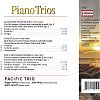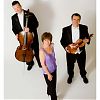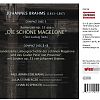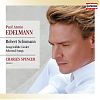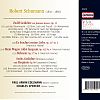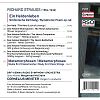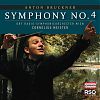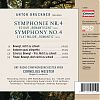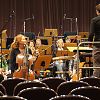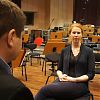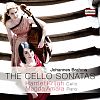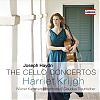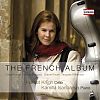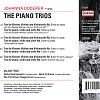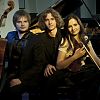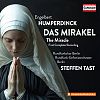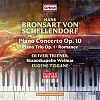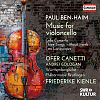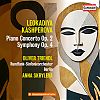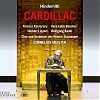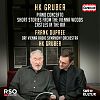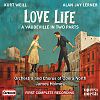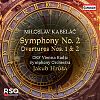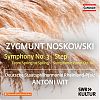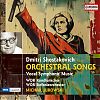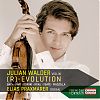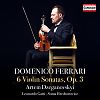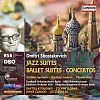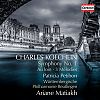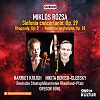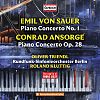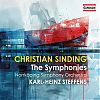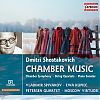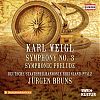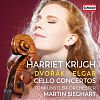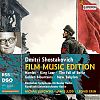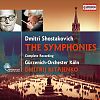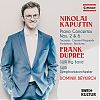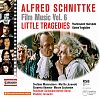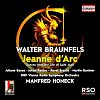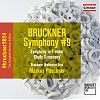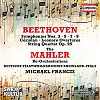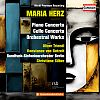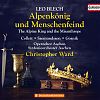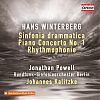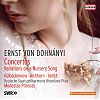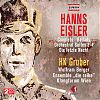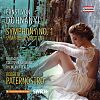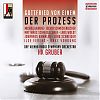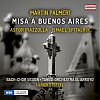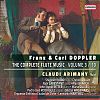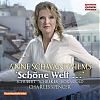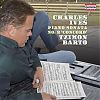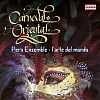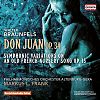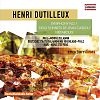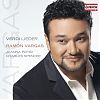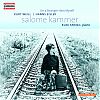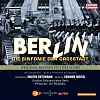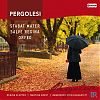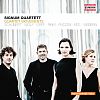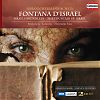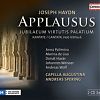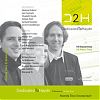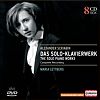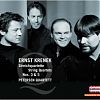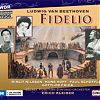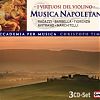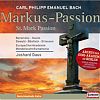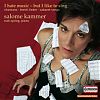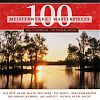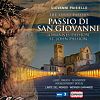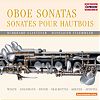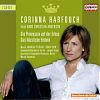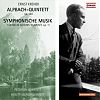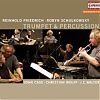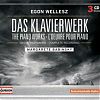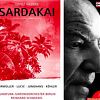cd
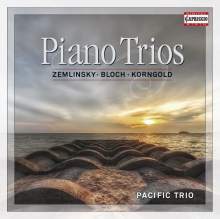
Piano Trios
Pacific Trio
ALEXANDER VON ZEMLINSKY (1871-1942)
Trio for Piano, Violin and Cello in D Minor, op. 3
ERNEST BLOCH (1880-1959)
Three Nocturnes for Piano, Violin and Cello
ERICH WOLFGANG KORNGOLD (1897-1957)
Trio for Piano, Violin and Cello in D Major, op. 1
PACIFIC TRIO
Roger Wilkie, Violine / violin · John Walz, Violoncello / cello
Edith Orloff, Klavier / piano
Zemlinsky, Korngold and Bloch also shared the fate of so many other important musical voices of the early twentieth century when their music was banned, and their lives and careers upended, by the Nazi regime. All three names can be found in the infamous Lexikon der Juden in der Musik, first published under the auspices of the Nazi Party in 1940. These policies, and others, created a rupture in the seamless heritage of German music, removing thousands of worthy works from performance, from publication and—for many— from posterity. It is the hope that musicians and music-lovers everywhere will hear these three works, and be intrigued to listen to—and to play—these and other chamber works by the many composers whose fortunes were curtailed by unfortunate timing on the stage of twentieth-century Europe. James Conlon
Weitere Bilder
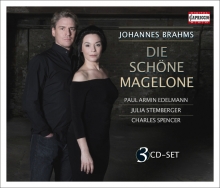
Johannes Brahms: Die schöne Magelone
Paul Armin Edelmann Julia Stemberger Charles Spencer
The Magelone cycle is full of strange contrasts. As an artistic edifice, it has a striking singularity. Brahms took his source from the true beginning of literary Romanticism. He sought a text that, for its part, pointed back further into the past, paying reverence to a folk tone steeped in tradition. Brahms composed trend-setting music for the piano, but in vocal terms considered proximity to the folk song appropriate. ‘Brahms, the progressive musician’, as Arnold Schoenberg termed him in an eponymous essay, showed himself from his typical side in the Magelone Songs.
The rising austrian star for Lied Recitals, Paul Armin Edelmann, take intensive care of this song cycle. Together with the famous austrian Theater- and Movie actor Julia Stemberger these CDs includes beside the Brahms Romances also the complete
literarly text by Ludwig Tieck.
Weitere Bilder
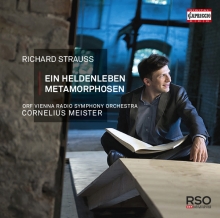
RICHARD STRAUSS
ORF Vienna Radio Symphony Orchestra Cornelius Meister
Ein Heldenleben op. 40 was written in 1898, so to speak at the end of a decade, in which Strauss with orchestral works such as Don Juan, Macbeth, Tod und Verklärung, Till Eulenspiegel’s lustige Streiche, Also sprach Zarathustra and Don Quixote had highly intensively and successfully set to music extra-musical stories with purely instrumental means. In the popular genre of programme music, he could justifiably count on a positive response on the part of his public.
The ORF Vienna Radio Symphony Orchestra under the direction of his chief conductor Cornelius Meister did a lot of performances of Richard Strauss works during the Jubilee year 2014. The Highlight of this concert series at the Vienna Konzerthaus was the “Heldenleben” performance, enthusiastic acclaimed by press and audience.
Weitere Bilder
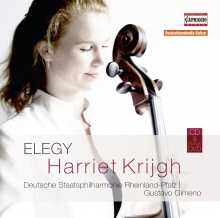
Harriet Krjigh: Elegy
Deutsche Staatsphilharmonie Rheinland-Pfalz · Gustavo Gimeno
VIDEO TRAILER
https://www.youtube.com/watch?v=2I29iiwSeds
Ernest Bloch: From Jewish Life - No. 1 Prayer · Max Bruch: Kol Nidrei, op. 47
Jules Massenet: Élégie · Jacques Offenbach: Les larmes de Jacqueline, op. 76/2
Gabriel Fauré: Élégie in C Minor | c-moll op. 24 · Pablo Casals: Song of the birds
Bonus – DVD
Harriet Krijgh
The Cello and the Rainbow | Das Cello und der Regenbogen
The Portrait – Das Portrait
Subtitles: English · Picture Format: NTSC / Colour / 16:9 · DVD Format: DVD 5
YouTube:
https://www.youtube.com/watch?v=2I29iiwSeds&list=UUr7KYgaquRN-_lVg-nlonHQ
Euripides interprets “Elegy”, the grand ancient song of lament, as a “barbaric, Asian cry of sorrow”. To some extent an exotic sound coloration also infuses the elegiac compositions of the European masters of romantic and early modern music that have been assembled for this CD.
Twenty-three year old Dutch cellist Harriet Krijgh is one of today’s most exciting and promising young cellists. Harriet has been invited on to the “Rising Star” series of the European Concert Hall Organisation (ECHO) for the 2015/16 season, she was nominated by Musikverein and Konzerthaus Vienna.
The included Bonus-DVD shows for the first time a documentary about life and career of the young cellist Harriet Krjigh.
Weitere Bilder
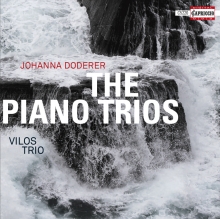
JOHANNA DODERER
Vilos Trio
Trio for piano, violin and cello No. 3 DWV 64 (2009)
„For the Gustav Mahler Jubilee 2010 and 2011“
Trio for piano, violin and cello No. 2 DWV 52 (2008)
„Dedicated to Haydn“
Trio for piano, violin and cello No. 1 DWV 31 (2002)
Trio for piano, violin and cello No. 4 DWV 79 (2013) „Morning“
VILOS TRIO
Dalia Dedinskaite, Violine / violin · Gleb Pyšniak, Violoncello / cello
Ole Christian Haagenrud, Klavier / piano
„I have the good fortune that I always really live in music“
Johanna Doderer studied composition in Graz with Beat Furrer (composition), later in Vienna with Klaus Peter Sattler (composition for film and media) and with Erich Urbanner (composition).
Her current work ranges broadly from Chamber Music to orchestral work and to meanwhile 6 operas.
“The classical instrumentation of a piano trio is a demanding task. It’s like a small orchestra. In terms of artistry, technique and knowledge, you have to be good enough to meet the sound a piano trio can produce. It’s absolute music.”
„…Doderer cares about content, not about cheap effect. As she perfectly masters her writing, she is able to prove convincingly in her very densely written score, that even today you can still create intense music by using sound models deriving from the late romantic period, and which can be combined in an ideal way with forms of ‚minimal music’…“ (Die Presse)


